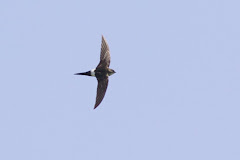New Year's Day was cold. Very cold. So my new snow boots with thermal linings were extremely welcome in the -8 temperatures in southern Sweden - the destination of my first birding in 2010. I caught the 0720 train from Copenhagen to Lund which was full of late night revellers on their way back to Sweden after spending New Year's Eve in Copenhagen. I had only managed two hours sleep myself due to a combination of a New Year's Eve party with some friends and then the constant bangs, whizzes and crackles of fireworks on Kongens Nytorv until 4am (incredibly the Danes spend an average of 50Kr each (about 6 GB pounds) on fireworks on NYE), but I knew that a few hours in the fresh Swedish winter would wake me up, hopefully accompanied by some good birds with which to kick off the year.
So my long tired self arrived in Lund to meet with
Phil who had driven down from Båstad. Our target species were Steppe Eagle (a young bird has been wintering just outside a small village, very close to the motorway from Malmo to Ystad and Gyrfalcon (an adult was wintering near Phil's patch at Farhult/Ronnen).
Our theory was that, being New Year's Day, there would be lots of people looking for the eagle to get it onto their 'year-lists' and so we would have little trouble finding it. How wrong we were - we didn't see another birder at the site in over 3 hours! Despite doing the circuit of public roads, and walking through the middle of the eagle's preferred territory, we drew a blank with a couple of White-tailed Eagles (the first of many) and a supporting cast of Goshawk, Crossbill, Red Kite (at least 5), Treecreeper, Nuthatch, White-fronted Goose (8),
taiga Bean Goose (4+) and lots of common stuff. Frustrating. So we took the decision, bearing in mind that the hours of daylight are severely limited at this time of year (around 0815 to 1545), to cut short the eagle hunt and go for the Gyr. The hour's drive produced Rough-legged Buzzard and a few more common birds and importantly gave us a chance to thaw out! We were soon in the Gyr area (incidentally the same area as wintering eagles - both White-tailed and Golden - you can see a map and suggested circular route
here. Here we saw one of the rarer sights of the day - other birders. We were treated to good numbers of White-tailed Eagles bringing our day-count into double figures but the Golden Eagle was more elusive. At the end of our first circuit of the area we caught sight of a bird of prey sitting on a concrete drain just 50 metres or so from the road. A quick check with the bins showed it to be a big falcon - GYR! The bird was pretty confiding, allowing us to get some prolonged and excellent views. It was a beast - like a big, stocky Peregrine with duller facial markings (lacking the pure white cheek of Peregrine) and had an almost 'hunchback'-like posture. I reeled off a few record photos (see below) before the bird flew a short distance further into the field and then sped off powerfully in a long arc towards the coast. What a bird. I had only seen my first Gyr last winter - a 1st-winter brown and streaked bird also in Sweden - so to see an adult was something special and made it a very good day.
We visited a couple of the local coastal sites to look for more year-ticks but the extreme cold (it was colder here than further south - it must have been around -10) and the fact that the sea was frozen for several hundred metres offshore, meant that viewing the sea duck and grebes was difficult. After seeing the odd Slavonian Grebe, Goosander, Goldeneye and other bits and bobs, we headed back to the station for me to get my train. One of the best, and coldest, New Year's Day birding I have had - cheers Phil!
Photos: Gyr












































